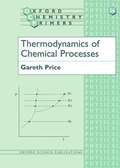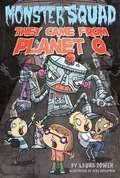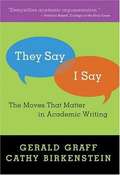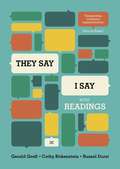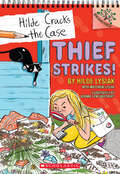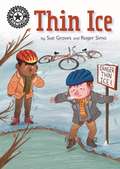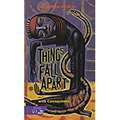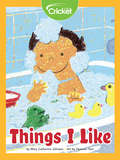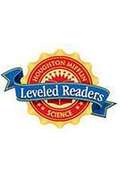- Table View
- List View
Thermal Energy: Using Water to Heat a School, Investigation Notebook with Article Compilation
by The Lawrence Hall of ScienceNIMAC-sourced textbook
Thermal Energy: Using Water to Heat a School, Investigation Notebook with Article Compilation
by The Lawrence Hall of ScienceNIMAC-sourced textbook
Thermodynamics Of Chemical Processes
by Gareth PriceThe Primer describes the basic principles which govern reactivity and phase equilibria in chemical systems. It is written at the first year undergraduate level and contains a number of worked examples and problems to help students through this introductory material. The ideas of enthalpy,internal energy and entropy are covered to lead into Gibbs free energy and how it can be used to correlate and predict the equilibrium position and properties of chemical reactions and multi-phase systems. Some background mathematical ideas are introduced as needed as well as material describing howthe physicochemical principles can be applied to related areas such as materials science or biochemistry
Thermodynamics of Natural Systems: Theory and Applications in Geochemistry and Environmental Science
by G. M. AndersonThermodynamics deals with energy levels and energy transfers between states of matter, and is therefore fundamental to all branches of science. This new edition provides an accessible introduction to the subject, specifically tailored to the interests of Earth and environmental science students. Beginning at an elementary level, the first four chapters explain all necessary concepts via a simple graphical approach. Throughout the rest of the book, the author emphasizes the importance of field observations and demonstrates that, despite being derived from idealized circumstances, thermodynamics is crucial to understanding ore formation, acid mine drainage, and other real-world geochemical and geophysical problems. Exercises now follow each chapter, with answers provided at the end of the book. An associated website includes extra chapters and password-protected answers to additional problems. This textbook is ideal for undergraduate and graduate students studying geochemistry and environmental science. Offers specially tailored treatment of thermodynamics for Earth and environmental science students Provides a more streamlined and accessible introduction for students with little prior knowledge of thermodynamics Uses examples and problem sets to highlight the connection between the idealized theory of thermodynamics and real-world geological and environmental problems Includes additional web resources, such as chapters on more advanced topics and password-protected solutions to problems in the book
These Are the Hands: A Tale of Water Restoration (Fountas & Pinnell Classroom, Guided Reading Grade 5)
by Elizabeth RuschNIMAC-sourced textbook
These Shoes (Fountas & Pinnell Classroom, Guided Reading)
by Cheryl BlockNIMAC-sourced textbook. On Your Feet. There are so many kinds of shoes. What are they for? What are they called?
They Called Him Mr. Bones (Fountas & Pinnell Classroom, Guided Reading Grade 4)
by Giorgio Bacchin Leslie BudnickDigger of Dinosaurs Barnum Brown spent his life digging up old bones. You might even recognize some of his famous discoveries. NIMAC-sourced textbook
They Came From Planet Q (Monster Squad #4)
by Laura Dower Dave SchlafmanStrange things are happening in the town of Riddle. All the silverware is missing! Fillings are falling out! The metal recycling machines are always empty! Could it have to do with the UFO Lindsey spotted through her camera lens? They must have come from Planet Q. But between the crafty Monster Squad and Lindsey?s photography skills, those metal heads will surely be stopped. .
They Say / I Say: The Moves That Matter in Academic Writing
by Gerald Graff Cathy Birkenstein"They Say / I Say" shows that writing well means mastering some key rhetorical moves, the most important of which involves summarizing what others have said ("they say") to set up one's own argument ("I say"). In addition to explaining the basic moves, this book provides writing templates that show students explicitly how to make these moves in their own writing.
They Say, I Say: The Moves That Matter in Academic Writing with Readings
by Russel Durst Gerald Graff Cathy Birkenstein"They Say / I Say" with Readings shows that writing well means mastering some key rhetorical moves, the most important of which is to summarize what others have said ("they say") in order to set up one's own argument ("I say"). Templates help students make these moves in their own writing, and 50 readings demonstrate the moves and prompt students to think-and write.
Thief Strikes!: A Branches Book (Hilde Cracks the Case)
by Matthew Lysiak Hilde LysiakCrime reporter Hilde Lysiak has to catch a thief!Pick a book. Grow a Reader!This series is part of Scholastic's early chapter book line, Branches, aimed at newly independent readers. With easy-to-read text, high-interest content, fast-paced plots, and illustrations on every page, these books will boost reading confidence and stamina. Branches books help readers grow!Real-life crime reporter Hilde Lysiak is starring in her very own early chapter book series -- inspired by real news stories she has written! In this sixth book, tomato plants are stolen from a local garden! Hilde needs to catch the thief fast. But when she and her sister Izzy interview witnesses, they discover something strange: people all around town are getting sick! Can this real-life reporter get to the ROOT of these two mysteries? Joanne Lew-Vriethoff's personality-filled illustrations appear on every page, bringing Hilde's adventures to life for young readers!
Thili Kannada Dwithiya Bhasha Kannada Patyapustaka class 7 - Karnataka Board: ತಿಳಿ ಕನ್ನಡ ದ್ವಿತೀಯ ಭಾಷಾ ಕನ್ನಡ ಪಠ್ಯಪುಸ್ತಕ ಏಳನೆಯ ತರಗತಿ
by Karnataka Patyapustaka Sanghaಇದು ಇಂಗ್ಲೀಷ್ ಮಧ್ಯಾಮ ಕನ್ನಡ ಭಾಷೆ-2 7ನೇ ತರಗತಿ ಕನ್ನಡ ಮಾಧ್ಯಮದ ಎಲ್ಲಾ ವಿದ್ಯಾರ್ಥಿಗಳಿಗೆ ಕರ್ನಾಟಕ ಪಠ್ಯ ಪುಸ್ತಕವು ಉಪಯುಕ್ತವಾಗಿದೆ.
Thili Kannada Second Laguage (English Medium) class 6 - Karnataka Board: ತಿಳಿ ಕನ್ನಡ ದ್ವಿತೀಯ ಭಾಷೆ ಆರನೇ ತರಗತಿ
by Karnataka Text Book Societyಇದು ತಿಳಿ ಕನ್ನಡ- ದ್ವಿತೀಯ ಭಾಷೆ ಆರನೇ ತರಗತಿ ರಾಷ್ಟ್ರೀಯ ಶಿಕ್ಷಣ ನೀತಿ ಪಠ್ಯಕ್ರಮದ ಪ್ರಕಾರ KTBS (ಕರ್ನಾಟಕ ಪಠ್ಯ ಪುಸ್ತಕ ಸಂಘ) ಇಂಗ್ಲಿಷ್ ಮಾಧ್ಯಮದ ವಿದ್ಯಾರ್ಥಿಗಳಿಗೆ ಶೈಕ್ಷಣಿಕ ಪಠ್ಯ ಪುಸ್ತಕವಾಗಿದೆ.
Thili Kannada Second Language (English Medium) class 9 - Karnataka Board: ತಿಳಿ ಕನ್ನಡ ದ್ವಿತೀಯ ಭಾಷೆ ಒಂಬತ್ತನೇ ತರಗತಿ ಆಂಗ್ಲ ಮಾಧ್ಯಮ
by Karnataka Text Book Societyಇದು ರಾಷ್ಟ್ರೀಯ ಶಿಕ್ಷಣ ನೀತಿ ಪಠ್ಯಕ್ರಮದ ಪ್ರಕಾರ KTBS (ಕರ್ನಾಟಕ ಪಠ್ಯ ಪುಸ್ತಕ ಸಂಘ) ಇಂಗ್ಲಿಷ್ ಮಾಧ್ಯಮದ ವಿದ್ಯಾರ್ಥಿಗಳಿಗೆ ಶೈಕ್ಷಣಿಕ ಪಠ್ಯ ಪುಸ್ತಕವಾಗಿದೆ.
Thili Kannada Second Language class 10 - Karnataka Board: ತಿಳಿ ಕನ್ನಡ ದ್ವಿತೀಯ ಭಾಷೆ ಹತ್ತನೇ ತರಗತಿ
by Karnataka Patyapustaka Sanghaಇದು ತಿಳಿ ಕನ್ನಡ ದ್ವಿತೀಯ ಭಾಷೆ ಹತ್ತನೇ ತರಗತಿಯ ಪಠ್ಯಕ್ರಮದ ಪುಸ್ತಕಗನ್ನು ಒಳಗೊಂಡಿದೆ.
Thili Kannada Second Language class 8 - Karnataka Board: ತಿಳಿ ಕನ್ನಡ - ದ್ವಿತೀಯ ಭಾಷೆ ಎಂಟನೇ ತರಗತಿ
by Karnataka Patyapustaka Sanghaಇದು ಎಂಟನೇ ತರಗತಿಯ ತಿಳಿ ಕನ್ನಡ - ದ್ವಿತೀಯ ಭಾಷೆಯ ಪಠ್ಯಪುಸ್ತಕಗಳನ್ನು ಒಳಗೊಂಡಿದೆ.
Thili Kannada Second Language class 9 - Karnataka Board: ತಿಳಿ ಕನ್ನಡ - ದ್ವಿತೀಯ ಭಾಷೆ ಒಂಬತ್ತನೇ ತರಗತಿ
by Karnataka Patyapustaka Sanghaಇದು ತಿಳಿ ಕನ್ನಡ - ದ್ವಿತೀಯ ಭಾಷೆ ಒಂಬತ್ತನೇ ತರಗತಿಯ ಒಂದು ಶೈಕ್ಷಣಿಕ ಪಠ್ಯಪುಸ್ತಕವು ಪ್ರಮಾಣಿತ ಇಂಗ್ಲೀಷ್ ಮಧ್ಯಮದ ಪುಸ್ತಕವು ಉಪಯುಕ್ತವಾಗಿದೆ.
Thin Ice: Independent Reading 11 (Reading Champion #300)
by Sue GravesWhen friends Lenny and Ted take their bikes off to the woods on a cold, snowy day, Mum warns them to keep away from the icy pond. The trouble is, Lenny just can't resist it and ends up nearly paying a very high price...Reading Champion offers independent reading books for children to practise and reinforce their developing reading skills.Fantastic, original stories are accompanied by engaging artwork and a reading activity. Each book has been carefully graded so that it can be matched to a child's reading ability, encouraging reading for pleasure.The Key Stage 2 Reading Champion Books are suggested for use as follows:Independent Reading 11: start of Year 3 or age 7+Independent Reading 12: end of Year 3 or age 7+Independent Reading 13: start of Year 4 or age 8+Independent Reading 14: end of Year 4 or age 8+Independent Reading 15: start of Year 5 or age 9+Independent Reading 16: end of Year 5 or age 9+Independent Reading 17: start of Year 6 or age 10+Independent Reading 18: end of Year 6 or age 10+
Things Fall Apart, with Connections
by Chinua AchebeThe classic novel Things Fall Apart along with related materials: a poem, interviews, a speech, fables, a short story, and a short biography of Achebe. <P><P><i>Advisory: Bookshare has learned that this book offers only partial accessibility. We have kept it in the collection because it is useful for some of our members. Benetech is actively working on projects to improve accessibility issues such as these.</i>
Things Fall Apart, with Related Readings
by Chinua AchebeFor use in teaching literature to high school students.
Things I Like
by Mary Catherine JohnsonFrom bubbles in the bath, to teddy bears in bed—it's all the things I like!
Things That Float (Fountas & Pinnell Classroom, Guided Reading Grade 1)
by Myka-Lynne SokoloffNIMAC-sourced textbook

